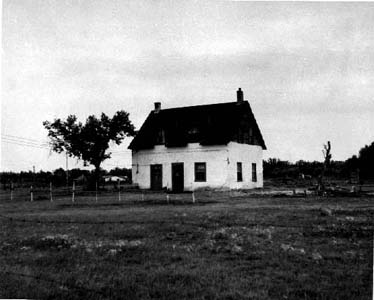Search | Image Archive | Reference | Communities | POV | Lesson Plans | Credits
 Through the second half of the nineteenth century, both sides of the Red River were dotted with small farms. The land was subdivided, according to the system that prevailed in Lower Canada (Quebec), into narrow lots a few hundred feet wide and seven miles deep. These river lots were designed to allow farmers to take maximum advantage of the river. Farms were laid out in such a way that each family preserved a woodlot in the river-bottom forest. The house and barn were situated at the elevation of the bank, and fields, pasture and hay-land stretched back from the river.
Through the second half of the nineteenth century, both sides of the Red River were dotted with small farms. The land was subdivided, according to the system that prevailed in Lower Canada (Quebec), into narrow lots a few hundred feet wide and seven miles deep. These river lots were designed to allow farmers to take maximum advantage of the river. Farms were laid out in such a way that each family preserved a woodlot in the river-bottom forest. The house and barn were situated at the elevation of the bank, and fields, pasture and hay-land stretched back from the river.
Although some of the owners of these plots were aboriginal or Québécois, the vast majority were Métis. Most practiced a kind of mixed farming that blended small-scale production of field crops with raising livestock. The farm provided subsistence plus some cash income, which was often supplemented with firewood cutting, hired labour and, before 1870, the Buffalo Hunt.
In the 1880s, the Letellier area underwent an economic transition. Located in the Red River Valley, it contained some of the most desirable agricultural land in the west, and farmers looked to the area to establish larger and more commercial farms. After 1870, the métis presence in the area declined as politics and irregularities in the distribution of métis lands drove many to the Northwest Territories and United States.
Many of those who arrived in the Letellier area in this same period were québécois. There was a land shortage in Quebec, and many families, mindful of the importance of leaving a sufficient land inheritance for their sons, looked to Manitoba and its offer of free land. While some came directly, many immigrated via New England or Minnesota, where they worked in factories or as labourers to earn the money to buy land and implements.
The settlers established Letellier as one of several largely Francophone communities arrayed along the Red River between Winnipeg and Emerson. These communities were united by language and culture and by the strong presence of the Catholic Church, which controlled many of the educational institutions. Community identity was reinforced by the development of French businesses and credit operations which allowed these communities to retain this strong québécois identity even in the face of efforts to purge the province of French language and Catholic religious education between 1880 and 1920.
TimeLinks Characters: John Matias, a wealthy farmer, has moved to Letellier from Quebec with his two sons.
Page revised: 29 August 2009